We may not have the course you’re looking for. If you enquire or give us a call on 01344203999 and speak to our training experts, we may still be able to help with your training requirements.
Training Outcomes Within Your Budget!
We ensure quality, budget-alignment, and timely delivery by our expert instructors.
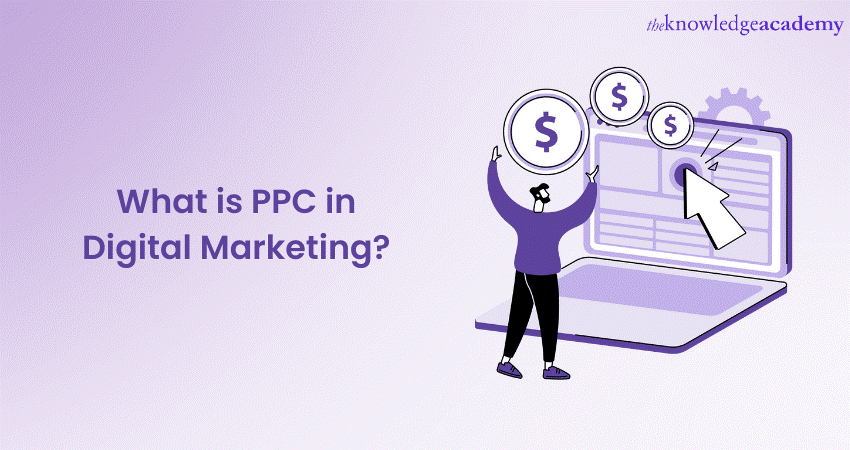
Are you new to Digital Marketing and struggling to mark your presence on all digital platforms? If yes, then one of the effective ways to achieve this goal is through Pay Per Click (PPC). But What is PPC? and how can it benefit your business?
According to Zenith’s Advertising Expenditure Forecasts report, global ad spend is estimated to grow 7.4% in 2024. It is because more and more brands are looking to leverage more social media, online video, advanced TV, and e-commerce channels.
So, if you haven’t started using this technique to mark your social media presence, it’s time to take action. Read this blog to learn What is PPC? Also, explore the Different Types of PPC advertising and its advantages in Digital Marketing.
Table of Contents
1) What is PPC in Digital Marketing?
2) Key elements of PPC
3) How does PPC in marketing work?
4) Different types of PPC Advertising
5) Top PPC platforms
6) Advantages of PPC in Digital Marketing
7) Conclusion
What is PPC in Digital Marketing?
One term that often arises in Digital Marketing is Pay Per Click (PPC). But what is PPC, and how does it fit into the broader realm of marketing strategies? Let’s find out.
PPC, or Pay Per Click, is an online advertising technique or model in which advertisers pay a fee each time their ads get clicked. It is a way for businesses to purchase website visits rather than relying solely on organic traffic.
The concept behind this model is relatively straightforward. First, the advertisers bid on specific keywords or phrases relevant to their products, services, or target audience. When a user searches for those keywords, an auction is held to determine what ads will be displayed. This auction considers bid amounts and the quality and relevance of the ads to the search query. Lastly, the ad with the highest bid and quality score usually secures the top position and gains visibility to potential customers.
The most popular platform for PPC advertising is Google Ads, where ads are displayed on Search Engine Results Pages (SERPs) when users search for relevant keywords. It is vital in Digital Marketing because it provides the following features:
Keyword targeting
PPC allows businesses to target specific keywords relevant to their products, services, or target audience. By bidding on these keywords, businesses can ensure that their ads are displayed when users search for those specific terms.
This keyword-targeting feature ensures that the organisation’s ads reach users who are actively seeking what you have to offer. This increases the chances of conversions and maximises the effectiveness of your advertising campaigns.
Need to boost your conversions and revenue, refer to our blog on "How to improve PPC performance"
Precise audience targeting
In addition to keyword targeting, it offers precise audience targeting options. Businesses can define their target audience based on demographics, location, interests, or behaviours.
This feature enables businesses to show their ads to the most likely to the most interested user in their offerings. As a result, organisations can improve the effectiveness and relevance of their ads, leading to higher click-through rates and better conversion rates.
Ad scheduling
PPC platforms often provide the feature of ad scheduling, allowing businesses to control when their ads are displayed. It enables businesses to show their ads during specific days of the week or particular times of the day when their target audience is most active or likely to convert. By strategically scheduling their ads, businesses can optimise their ad spend and ensure that their ads are shown at the most reasonable times to reach their target audience.
Ready to enhance your marketing skills? Explore our comprehensive Marketing Training.
Ad customisation
Ad customisation features include options to do the following:
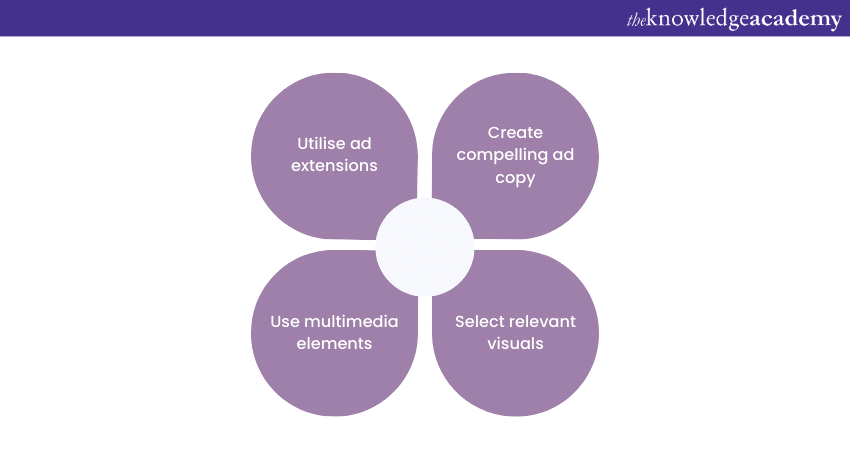
These help provide additional information or links. Further, customising ads helps organisations stand out, attract users’ attention, and effectively communicate their unique selling points or offers.
Real-time performance tracking
PPC campaigns have robust tracking and analytics tools that provide real-time performance data. These tools allow businesses to monitor key metrics such as impressions, clicks, click-through rates, conversions, and cost per conversion.
Furthermore, real-time performance tracking enables businesses to assess their campaigns’ efficiency, identify improvement areas, and make data-driven decisions to optimise their strategies. This feature empowers businesses to refine their campaigns and achieve better results over time continuously.
Budget control
Using PPC, businesses can have full control over their advertising budget. Advertisers can set daily or monthly spending limits, adjust bids, and pause or stop campaigns.
This budget control feature ensures businesses can allocate their resources effectively, optimise their ROI (ROI), and prevent overspending. Additionally, the flexibility in budget control makes it a suitable advertising option for businesses of all sizes and budgets.
Key elements of PPC
When running successful campaigns using PPC, data-driven decision-making is crucial. The metrics and analytics provide valuable insights into the performance of business campaigns to make better management decisions. By understanding and analysing these metrics, businesses can optimise their strategies and drive better results. So, let’s explore some key PPC metrics and the role of analytics:
Click-Through Rate (CTR)
CTR measures the percentage of users clicking on an ad after seeing it. It is computed by dividing the ad clicks quantity by the number of ad impressions.
A high CTR indicates that an organisation’s ads are compelling and relevant to its target audience. Monitoring CTR helps you assess the effectiveness of their ad copy, ad position, and targeting.
Conversion Rate (CR)
Conversion Rate (CR) measures the percentage of users who complete the desired action. It includes purchasing, filling out a form, or subscribing to a newsletter after clicking on your ad.
It is calculated by dividing the number of conversions by the number of ad clicks. The higher the conversion rates, the higher will be ads and landing pages are effectively persuading users to take the desired action.
Return on Ad Spend (ROAS)
This metric measures the revenue generated for every dollar spent on advertising. It is derived by dividing the total revenue generated from campaigns by the total cost of those campaigns.
As a result, ROAS helps you evaluate the profitability of campaigns and make informed decisions about budget allocation and campaign optimisation.

Quality score
Quality score is a metric used by platforms like Google Ads to assess the quality and relevance of an organisation’s keywords, ads, and landing pages. It is determined based on expected CTR, ad relevance, landing page experience, and historical performance.
A high-quality score can positively impact their ad position. This can also reduce the Cost Per Click, improving the overall efficiency of their PPC campaigns.
Cost per Click (CPC)
CPC refers to the amount organisations pay for each click on an organisation’s ads. It is influenced by various factors, including bid competition, ad relevance, and quality score. Monitoring CPC helps them manage their budget effectively and assess the cost-effectiveness of their PPC campaigns.
Impressions
Impressions are the number of times ads are shown to users. Tracking impressions provides insights into the reach and visibility of organisations’ PPC campaigns.
High impressions indicate that a large audience is seeing their ads. But it’s important to analyse other metrics, such as CTR and conversion rate, to determine the effectiveness of campaigns.
Cost per conversion
Cost per conversion measures the average amount spent on PPC Advertising for each conversion achieved. It is calculated by dividing the total cost of your campaigns by the total number of conversions.
Monitoring this helps one evaluate the efficiency of their advertising spend and identify areas for improvement.
Analytics and campaign optimisation
PPC Tools provide valuable data that can be used to optimise campaigns. By analysing the metrics mentioned above, organisations can identify trends, patterns, and areas for improvement.
This data-driven approach allows them to make informed decisions about bid adjustments, keyword optimisation, ad copy refinement, and landing page enhancements. Regular monitoring and analysis of these metrics help them refine their strategies and achieve better results over time.
How does PPC in marketing work?
After you have read What is PPC in marketing, it’s time to explore its inner workings and shed light on the process behind its effectiveness in delivering results for advertisers:
1. Keyword selection
The foundation of any PPC campaign lies in keyword selection. Advertisers must identify the most relevant keywords or phrases for their products, services, or target audience. Thorough keyword research is crucial to ensure that the chosen keywords align with user search intent and have sufficient search volume.
2. Ad creation
Once the keywords have been determined, the next step is developing compelling ads to capture users’ attention. The ad copy must possess the following features:
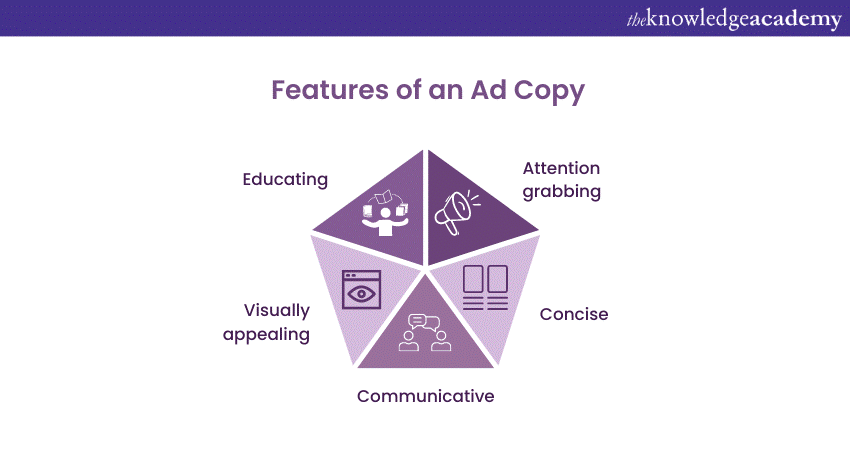
It is essential to highlight the above benefits or solutions offered by the products or services to entice users to click on the ads.
3. Bidding and budgeting
PPC operates on a bidding system, where advertisers compete for ad placement based on selected keywords. Advertisers set a maximum bid, representing the highest amount they are willing to pay for a click on their ad. However, the bid amount alone does not determine the ad placement; other factors come into play.
4. Ad rank and ad placement
Search engines consider a combination of factors to determine ad placement. One critical factor is the ad rank, calculated based on the bid amount and the ad's quality score. The quality score considers the relevance and quality of the ad, the landing page experience, and the expected Click-through Rate (CTR).
The auction takes place whenever a user initiates a search using one of the chosen keywords. The search engine evaluates the eligible ads based on their ad rank, and the highest-ranking ads are displayed on the SERP.
5. Ad display and cost calculation
Advertisers do not incur costs when an ad is displayed on the SERP. The actual cost is only incurred when a user clicks on the ad. Hence the term “Pay Per Click.” The Cost Per Click (CPC) is determined by factors such as the competitiveness of the keyword, the quality score, and the maximum bid amount set by the advertiser.
6. Ongoing optimisation
These campaigns require ongoing optimisation to maximise their effectiveness. Advertisers can refine their keyword selection, adjust bids, test different ad variations, and improve landing pages to enhance the overall performance of their campaigns. Continuous monitoring and analysing campaign data are crucial to drive better results over time.
a) Learn how to adopt a Plan to Brand/Market Needs.
Gain an in-depth understanding of marketing audit with our Introduction To Marketing Training.
Top PPC platforms
Several platforms offer robust advertising solutions, each with its own unique features and benefits. Let's find out some of the top PPC platforms that businesses can leverage to maximise their advertising efforts:
Google Ads
Google Ads, formerly known as Google AdWords, is the leading PPC platform and the most popular choice for businesses. It offers a variety of ad options, including the following:
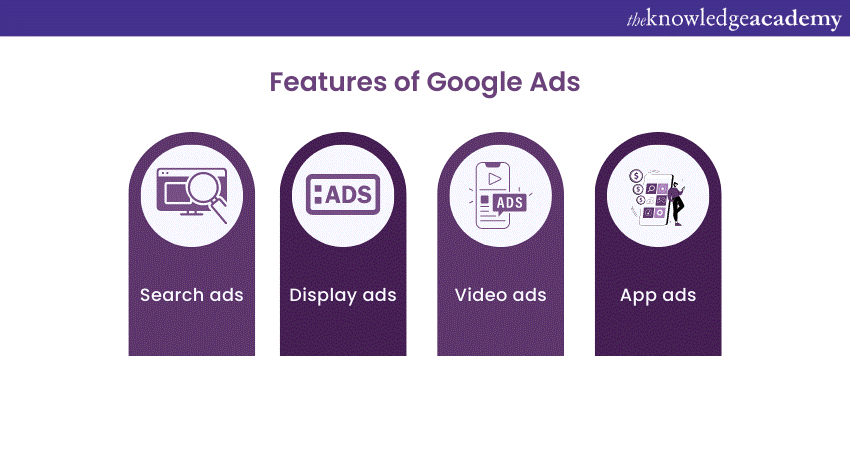
With Google Ads, businesses can target their ads based on specific keywords, demographics, locations, and interests. The platform provides powerful analytics and tracking tools, allowing businesses to examine the effectiveness of their campaigns and optimise their strategies accordingly.
Microsoft Advertising
With Microsoft Advertising, businesses can display their ads on the Bing search engine, as well as partner sites like Yahoo and AOL. The platform offers similar ad formats to Google Ads, allowing businesses to target specific keywords, demographics, and locations.
As a result, it provides robust audience targeting options and integrates with other Microsoft products, offering advertisers a unique reach and audience.
Facebook Ads
Facebook Ads allow businesses to create highly targeted ads based on demographics, interests, behaviours, and connections. The platform also provides a range of ad formats, like image ads, video ads, carousel ads, and sponsored content.
Furthermore, Facebook Ads provides extensive audience insights and targeting options, allowing businesses to reach their ideal audience and drive engagement, leads, and conversions.
Instagram Ads
Instagram Ads is the PPC platform specifically designed for advertising on the popular image and video-sharing social media platform. As a part of Facebook Ads, it offers similar audience targeting options and ad formats.
Businesses can create visually appealing ads that align with the platform's aesthetic, reaching a wide audience of engaged users. Instagram's extensive reach and highly visual nature make it an ideal platform for businesses focused on brand awareness and visual storytelling.
Twitter Ads
Twitter Ads allows businesses to create promoted tweets, promoted accounts, and promoted trends to increase their visibility and engagement on the platform.
Further, Twitter offers various targeting options based on demographics, interests, and keywords. The platform is particularly effective for businesses that generate buzz, engage with their audience, and drive website traffic or app installs.
Different types of PPC Advertising
By understanding the Different Types of PPC Advertising, businesses can choose the most suitable platforms and strategies to maximise their advertising effectiveness. So, let’s look at some of its key types:
1. Search advertising
This is one of the most common and widely used forms of PPC advertising. It involves displaying text ads on SERPs when users search for specific keywords or phrases. The ads appear at either the top or bottom of the search results and are often labelled as “sponsored” or “ad.”
Google Ads is the most popular search advertising platform, allowing businesses to bid on keywords and display their ads to users searching for relevant terms.
2. Display advertising
Display Advertising involves the placement of visual banner ads on websites within a network of publishers. These ads can include the following elements:
a) Images
b) Videos
c) Other interactive elements or infographics
They appear on websites that have opted to display advertising through platforms like Google Display Network. It allows businesses to target specific customers on the basis of demographics, interests, or website content. Further, it provides a visually engaging way to raise brand awareness and capture the attention of potential customers.
3. Social media advertising
Platforms like Facebook, Instagram, Twitter, and LinkedIn provide robust advertising tools that enable businesses to create highly targeted ads. Social media advertising allows businesses to do the following:
a) Engage with their audience
b) Promote products or services
c) Drive website traffic
d) Generate leads
As a result, these platforms offer a wide range of ad formats, including images, videos, carousel ads, and sponsored content.
4. Remarketing or retargeting approach
Remarketing, also known as retargeting, targets users who have previously visited an organisation’s website or shown interest in your products or services.
It allows you to display ads specifically to these users as they browse other websites or platforms within a network. By staying top-of-mind with potential customers who have already expressed interest, remarketing can help increase conversions and drive repeat visits.
5. Video Advertising
This type of PPC Advertising has gained significant popularity in recent years. Platforms like YouTube offer advertising options that allow businesses to display video ads before, during, or after user-selected videos.
These video ads can be highly engaging and potentially captivate audiences with compelling storytelling and visual content. Therefore, businesses can target their video ads based on demographics, interests, or keywords. This helps them reach users interested in their products or services.
Understand the use of market research in business models and frameworks with our Marketing Research Masterclass.
Advantages of PPC in Digital Marketing
PPC Advertising offers a range of advantages that can significantly impact the success of online marketing campaigns. So, let's explore some of the key advantages of PPC in Digital Marketing:
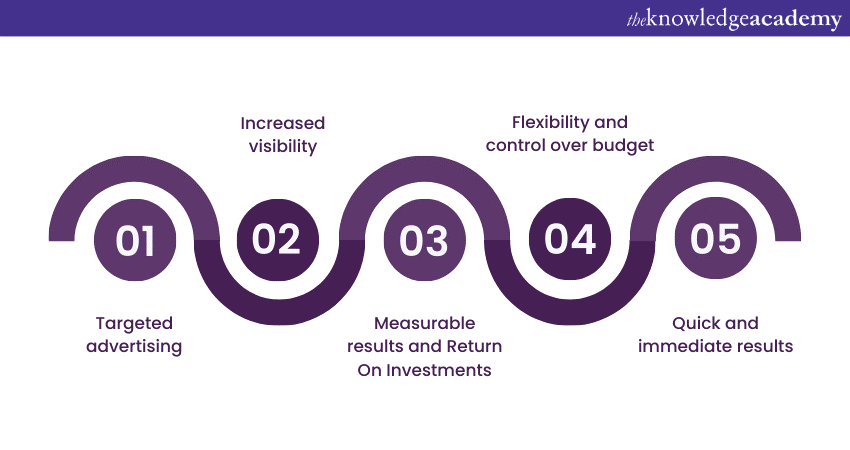
Targeted advertising
PPC allows businesses to precisely target their ads to specific keywords, demographics, locations, and even interests. This level of targeting ensures that their ads are shown to the relevant audience, increasing the chances of attracting potential customers.
Increased visibility
With PPC, businesses can bid on relevant keywords. Their ads can appear prominently on SERPs, making their brand more visible to users searching for specific terms related to their business. This enhanced visibility helps create brand awareness and establishes its presence in the competitive digital landscape.
Measurable results and Return on Investments (ROI)
Through PPC analytics and tracking tools, businesses can monitor the performance of their campaigns. It helps them gain insights into key metrics such as click-through rates, conversion rates, and cost per conversion. This data-driven approach allows for the optimisation and adjustment of campaigns to maximise Return on Investments (ROI) and drive better results.
Flexibility and control over budget
Unlike traditional advertising methods, where fixed costs are incurred, this model allows businesses to set a budget and allocate funds based on specific requirements. They can adjust bids, pause campaigns, and make real-time modifications, ensuring their budget is utilised effectively and efficiently.
Quick and immediate results
PPC provides instant visibility. Once campaigns are set up and approved, the organisation’s ads can start appearing and almost instantly drive traffic to their website. This immediacy can particularly benefit businesses seeking immediate leads, sales, or promotional opportunities.
Conclusion
We hope that after reading this blog, you have got a detailed overview of What is PPC. By harnessing its various features, businesses can optimise their campaigns, allocate their budget effectively, and achieve measurable success in online advertising. So, use this powerful tool to increase brand visibility and target audience and drive tangible results.
Ready to master PPC advertising? Register for our Pay Per Click (PPC) Masterclass now!
Frequently Asked Questions
Upcoming Digital Marketing Resources Batches & Dates
Date
 Pay Per Click (PPC) Training
Pay Per Click (PPC) Training
Fri 16th Aug 2024
Fri 18th Oct 2024
Fri 20th Dec 2024







 Top Rated Course
Top Rated Course


 If you wish to make any changes to your course, please
If you wish to make any changes to your course, please


